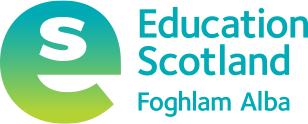LGBT inclusive education
LGBT inclusive education was introduced in Scotland following recommendations made by a national education working group tasked with identifying solutions to prejudice and bullying in schools. It benefits everyone by creating a safe and supportive environment for all learners, regardless of their sexual orientation or gender.
This approach integrates Lesbian, Gay, Bisexual and Transgender (LGBT) people and history into Scotland’s curriculum, addressing past exclusion and underrepresentation. It helps learners see LGBT people as equal members of society and ensures LGBT young people feel included in their education. It equips schools to tackle prejudice and bullying faced by LGBT students, those perceived to be LGBT, or those with LGBT family members. Through addressing gender stereotyping and inequality LGBT inclusive education also contributes to preventing gender-based violence.
Representing LGBT themes within learning and teaching can prevents harmful stereotypes and stigma from arising, which often lead to prejudice or bullying. It also allows children and young people to see themselves and their families reflected throughout their learning pathway. This approach aligns with how educators address other forms of inclusion, such as race, disability, gender, and religion. This helps learners to understand the world around them and the diverse society that they live in. It encourages respect for differences, builds empathy and helps to prevent bullying.
LGBT inclusive education aligns with the national approach to anti-bullying (gov.scot) which supports the development of a school curriculum which fosters good relations by including meaningful, integrated representation of all protected characteristics and opportunities for organic learning about diverse people, families and communities in society.
LGBT inclusive education also links closely to children’s rights in Scotland, specifically supporting articles such as freedom from discrimination (article 2), the right to an identity (article 8) and the right to be heard (article 13). LGBT inclusive education and the United Nation’s Conventions on the Rights of the Child promote equality, safety, and inclusion, ensuring children’s rights are protected and respected.
The National Approach to LGBT Inclusive Education
The National Guidance on LGBT Inclusive Education sets out the ‘National Approach to LGBT Inclusive Education’ and includes content relating to professional learning, what LGBT Inclusive Education looks like in practice, and how it connects to broader education in Scotland. The guidance outlines that schools and education settings should integrate LGBT Inclusive Education across curriculum in line with the national approach. LGBT inclusive education is suitable for the age and stage of children and is part of everyday teaching.
Learning content should be differentiated for the age and stage of learners. This means that what is taught at primary school is different to secondary. How this looks in practice will be decided by the school. Examples might include:
-
In the early years and primary: a story time book read throughout the year features a family with two mums or two dads
-
In upper primary school: an explanation of prejudice and discrimination may be introduced, for example, learning about homophobia by exploring the harms of using phrases like ‘that’s so gay’
-
At secondary school: social subjects might include learning about equality in more depth, such as the history of LGBT equality movements or the lives of past and present figures, such as Alan Turing or Sally Ride
-
At secondary school: books, plays or other teaching resources could be used during ordinary learning might include LGBT characters, themes or be written by LGBT authors
Time for Inclusive Education manage the national platform for LGBT Inclusive Education on behalf of the Scottish Government. It hosts all quality approved resources, the national ‘Delivering LGBT Inclusive Education’, the LGBT Inclusive Education Implementation and Evaluation Toolkit and all current national guidance.
Professional Learning
The LGBT Education Platform supports teachers across Scotland to address prejudice through education.
Teachers can access free curriculum resources and professional learning, including the Stage 1 e-learning module from the two-stage national course.
Learning and teaching resources
Quality approved resources and materials are available to support practitioners to integrate LGBT inclusive education learning themes across the curriculum. These include lesson plans, worksheets, book reviews, and multimedia learning materials. All resources are linked to Scotland’s Curriculum.
